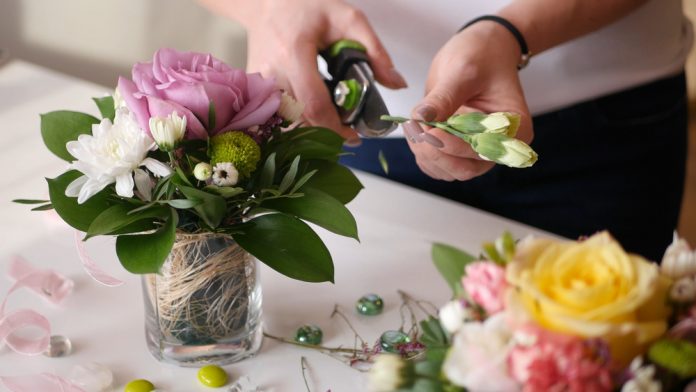
The readers of this magazine already know the many benefits of a corporate wellness program or an in-office “wellness space.” Increased productivity, increased creativity, reduced absenteeism, better teamwork, stress relief, and improved workplace morale are all positive byproducts of corporate wellness initiatives.
Workplace wellness programs have expanded in the last two decades to include yoga, team-building retreats, meditation, and art therapy. If you’re offering any of these activities to your employees, you’ve likely seen the results with your own eyes. For those of you looking for fresh, engaging ways to encourage a productive, mindful, happy and creative workspace, there’s a new activity some organizations are offering. It might be the most enlivening and brightening practice yet: workplace flower arranging.
Why flowers?
Why flowers? Gifting your employees (in-office or remote) with a flower arranging workshop offers them a connection to nature. A Rutgers University study found evidence that bringing a living element of the great outdoors inside and onto office desks is mood-boosting, focus-inducing, and calming. Throughout Japanese history, army generals practiced Ikebana, a form of flower arranging, before heading into battle to calm their minds and sharpen their concentration on the battlefield.
In the office or at corporate events, flower arranging shares many of the same benefits as traditional art therapies like painting and crafting, but it doesn’t stop there. Instead of working with paints and canvases, employees have the multi-sensory experience of creating with living things. Lisianthus is believed to inspire creativity; chrysanthemum and gerbera daisies are known to improve indoor air quality and human mood; jasmine encourages calm and comfort, and brightly-colored calendulas are said to have healing powers.
The scents, the feel of the petals, and the colors of various flowers are all mood-enhancing feasts for the senses. Just touching and working with flowers can promote calm feelings. Additionally, the art project is not over once the bouquet is done. Flower arrangements need longer-term care to prolong the vase’s life, promoting daily attention to detail long after the initial activity.
How does flower arranging translate to the workplace?
But how does the creative process of flower arranging translate to more productive employees? Creative outlets like painting, sculpting, and flower arranging require a lot of decision-making (i.e., choosing blooms, color palettes, etc.), forcing a person to be present. The process is meditative, which can be centering and restorative. There’s also liberation in knowing there is no right or wrong way to design a bouquet. The realization that there’s no way to “mess up” the project frees and resets a person. Just the act of expressing oneself creatively is proven to relieve stress. Who doesn’t need more stress relief in these uncertain times?
Flower arranging effectively checks off three boxes of corporate wellness support: emotional wellness (the process is meditative and calming), social wellness (workshops allow for mindful socializing with co-workers), and environmental wellness (bouquets beautify the workplace, which is proven to boost moods). Does an employee have writer’s block? Has an accountant been staring at a spreadsheet all day, crunching numbers? Is a salesperson on the phone repeating the same sales pitch hour after hour? Is a fast-approaching deadline causing anxiety and stress? Have your employees take a break and do a refreshing flower-arranging session. When you get your staff to stop and smell the flowers, the workplace benefits are many.




